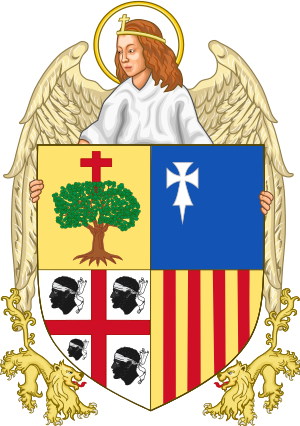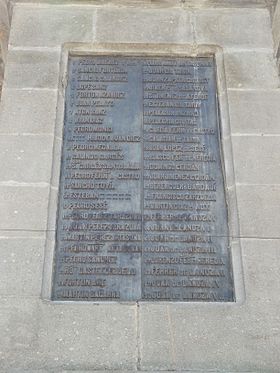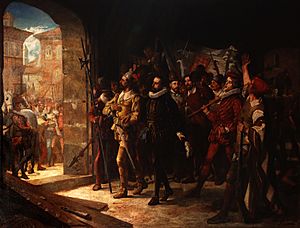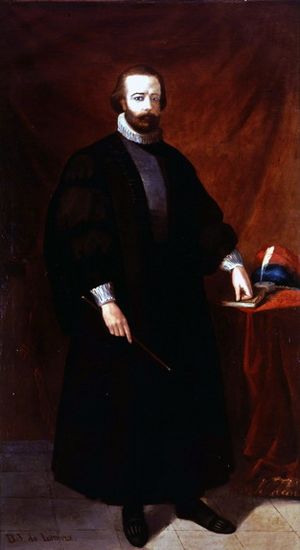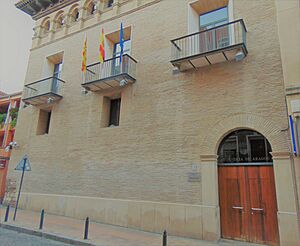Justicia de Aragón facts for kids
The Justicia de Aragón (pronounced: hoos-TEE-thya day ah-rah-GONE) was a very important public job in the old Kingdom of Aragon. It existed from at least the 1100s until 1711. It was brought back in 1982.
The Justicia was one of the most powerful people in Aragon, second only to the king. Their main job was to make sure that the laws (Fueros) and traditions of the land were followed. The Justicia had strong powers to judge cases and make decisions. They acted as a check on the king's power.
The Justicia also led the yearly meetings of the Cortes de Aragon (Aragon's parliament). They were in charge of making new kings promise to follow the laws. The Justicia could even stop actions by any official, including the king, if they thought it broke Aragon's laws.
This important job was stopped in 1711 when new laws united the Spanish monarchy. But it was brought back in 1982. Today, the Justicia acts like a regional ombudsman. This means they help people who feel they have been treated unfairly by the government.
Contents
History of the Justicia
How the Office Began
For a long time, people wondered how the Justicia office started. They wanted to know why the king's power in Aragon was so limited by laws. There were two main ideas about how the Justicia began. Both ideas suggested the office was as old as the Kingdom of Aragon itself.
The Legend of Iñigo Arista
One old story says the Justicia office started with Iñigo Arista. He was a very early king, around the 800s. The story claims he only agreed to be king if a special judge was chosen. This judge would settle any arguments between the king and his people. This judge was the first Justicia.
According to this legend, King Arista promised that the Justicia's job would never be ended. If any king tried to end it, the people had the right to remove that king. They could even choose a new one. This story showed how important it was for the king to follow the laws.
The Legendary Fueros de Sobrarbe
Another legend links the Justicia to the famous Fueros de Sobrarbe. These were said to be very old laws from a valley called Sobrarbe. This valley was where Aragon's fight against the Arabs began in the 1000s.
These "Fueros" were supposedly older than the Kingdom of Aragon itself. People used them to explain why the Justicia had so much power. They also used them to justify many other Aragonese institutions.
Most historians today believe that the Kingdom of Sobrarbe and its "Fueros" probably never existed. They think these stories were made up later. They were used to give legal reasons for the laws and traditions of the time. These legends helped to show that the laws of Aragon were more important than the king. They also supported the right of people to ignore royal orders they thought were illegal.
How the Office Grew Stronger (1265-1442)
The first real historical mention of a "Justicia" was in 1115. A document from King Alfonso the Battler mentioned a "Justice of the King." This person was in charge of making sure the king's laws were followed. It seems the Justicia started as a legal helper to the king. But it quickly became an independent office. Its job was to make sure all the laws and traditions of Aragon were kept.
By 1265, the Justicia office was very well established. In that year, the Aragonese parliament confirmed the Justicia's role. They were to settle legal arguments between the king and groups protected by Aragon's laws. These groups included nobles, clergy, and townspeople.
In 1283, the "Privilegio General de Aragón" made the Justicia even more powerful. It gave the Justicia power over arguments among nobles and cities too. So, the Justicia became a key protector of legal fairness in Aragon.
The Right of Manifestación
The Justicia's power grew even more in 1325. The nobles and cities of Aragon made King James II of Aragon issue a new law. This law was called the "Declaratio Privilegii generalis." It was like Aragon's own Magna Carta.
This new law banned torture in Aragon. It also created ways to prevent illegal arrests and imprisonment. These rules were similar to what we call habeas corpus today. They came even before habeas corpus. This process was known as the "Manifestación de personas." It meant "showing of persons."
The "Manifestación" worked like this: If someone was arrested, they could ask the Justicia for help. The Justicia would then order the arresting judge or official to hand over the person. This was to make sure no harm came to the accused before a fair trial. The Justicia also made sure the trial and sentencing followed all laws. Only after this would the Justicia return the person for punishment. If an official refused to hand over the prisoner, they were breaking the law themselves. This right stopped prisoners from being tortured or held illegally.
While waiting for trial, the Justicia protected the accused. Often, the accused person was set free until their trial. Sometimes, they were put under house arrest. Or they might go to the "prison of manifestados," which was known for being very mild. All accused people had the right to a lawyer. They also had the right to see all the legal papers and evidence against them. This helped them prepare their defense.
Who Held the Office?
The Justicia was usually a job for noble families. At first, it was a temporary job. But by the late 1400s, it became a job for life. It was often passed down from father to son.
The first Justicia whose dates are known was Pedro Martínez de Artasona in 1281. After Aragon joined with Catalonia, the Justicia became the speaker of the Aragonese parliament. This meant their names were recorded more often.
In 1442, during the reign of Alfonso V of Aragon, the Aragonese parliament made a big change. They used the king's need for money to fund his wars. They got him to agree that the Justicia could not be fired by the king. After this, the job became a lifelong position.
The first Justicia appointed for life was Ferrer de Lanuza I. He served from 1439 until he died in 1479. His son, Juan de Lanuza I, took over after him. Then Juan's son, Juan de Lanuza II, became Justicia. For many years, all Justicias came from the powerful Lanuza family.
During this time, the Justicia often had other important jobs, like being a viceroy in other kingdoms. So, they started to let their assistants, called "Lieutenants of the Justicia," do much of the work. These lieutenants were expert lawyers. This made the Justicia office more of an institution run by experts, even though a noble family held the main title.
The Antonio Pérez Affair (1591)
The Justicia often stood up to the king to protect Aragon's rights. The most famous conflict happened in 1591. This was during the Antonio Pérez affair. Pérez was a former secretary to King Philip II of Spain. He was accused of wrongdoing and arrested in Castile.
In 1590, Pérez escaped and fled to Aragon. He used his family ties to Aragon to ask the Justicia for protection. The Justicia at the time, Juan V de Lanuza, immediately agreed.
This meant Pérez could not be sent back to Castile without a proper trial in Aragon. He was placed in the "prison of manifestados." Here, he had much freedom and could prepare his defense. Pérez and his friends said that the king's attempts to get him back were an attack on Aragon's laws. The Justicia and other Aragonese officials supported Pérez. They blocked the king's efforts.
The king then tried to use the Inquisition (a church court) to charge Pérez. The Inquisition had power in both Castile and Aragon. When Pérez was moved to face the Inquisition, people in Zaragoza rioted. Pérez had to be returned to the "prison of manifestados."
This attempt to use the Inquisition made many people in Aragon angry. They saw it as the king trying to ignore Aragon's laws. Riots spread across Aragon. This period is known as the "Alteraciones de Aragón" (Disorders of Aragon). The situation became so bad that the king sent his army into Aragon.
The Justicia, Juan de Lanuza, and other Aragonese leaders declared the army's entry illegal. They called on Aragonese people to fight the king. The Justicia tried to gather troops, but his forces were much smaller than the king's army. In November 1591, the royal army entered Zaragoza without a fight.
Antonio Pérez escaped to France. But Justicia Juan V de Lanuza was captured. King Philip II had him executed in early 1592. He was accused of helping the riots and leading a rebellion.
To calm Aragon, King Philip II made some changes to Aragon's laws in 1592. The Justicia's office was kept, but it was now under the king's control. The king would choose future Justicias. This meant the office was no longer as independent as it once was.
End of the Old Office (1711)
The last Justicia to be regularly appointed was Miguel de Jaca y Niño in 1700. During the War of the Spanish Succession (1702–1714), Aragon sided with a different king. In 1706, the new king appointed a new Justicia, Domingo Antonio Gabín. He would be the last Justicia of the old line.
When the other side's troops took over Aragon in 1707, Justicia Gabín was put in prison. In 1711, the new King Philip V of Spain passed a new law. This law ended the Justicia office and Aragon's special laws. Aragon's institutions became part of the Spanish monarchy. The kingdom lost its independence.
The Modern Justicia
In the 1800s, the old Justicia office became a symbol for Aragon. It represented Aragon's history of independence and standing up to unfair royal power.
In 1982, after almost 400 years, the office of the Justicia de Aragón was brought back. This happened when Aragon passed its new Statute of Autonomy. The modern Justicia's powers are mostly like an ombudsman. They help protect people's rights and make sure the government acts fairly.
However, the modern Justicia still has some special roles. They defend Aragon's Statute of Autonomy. They also oversee Aragon's legal system, especially its private laws.
See also
 In Spanish: Justicia de Aragón para niños
In Spanish: Justicia de Aragón para niños



